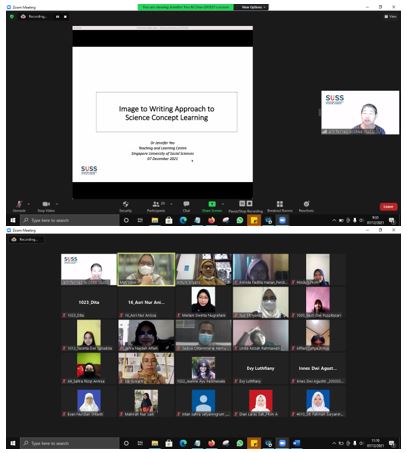 Bahasa Indonesia
Bahasa Indonesia English
English
You are here
Guest Lecture Chemistry Learning Model: Dr. Jennifer Yeo

Chemistry Learning Model is one of the compulsory subjects for Chemistry Education Study Program students, Faculty of Mathematics and Natural Sciences, UNY, which is taken in the third semester. As a form of implementing the MBKM Curriculum, and preparing graduates who are insightful who are ready to compete globally, the Chemistry Education Study Program held a test lecture activity with Dr. Jennifer Yeo, senior lecturer at the Teaching and Learning Center, Singapore University of Social Science. Dr. Jennifer was present as a teacher of the Chemistry Learning Model course, for students of the Chemistry Education Study Program, Faculty of Mathematics and Natural Sciences, UNY, online through the Zoom Meeting, Tuesday, December 07, 2021. Dr. Jennifer Yeo is active in conducting research in the field of multimodality, meaning-making, constructivists' learning chemistry education, teacher professional learning and pedagogical content knowledge, practice-based work.
On this occasion, Dr. Jennifer Yeo delivered material on Image to Writing (I2W) Approach to Science Concept Learning. Student interaction and participation was built since the beginning of the lecture with the question and answer method, and small group discussions at the breakout room zoom meeting. Students learn about the definition of science concepts, the I2W approach, and designing a chemistry learning approach with I2W. Based on the explanation of Dr. Yeo, a scientific concept is a network of semantic meanings. In chemistry, which studies about temperature, energy, heat, oxidation, ionization. Without a physical form, different modalities are used to represent concepts, which are often technical or specialized; unique to the scientific community. Science concepts are relevant to everyday life, such as energy as a form of heat causes temperature changes and flows when there is a temperature difference. For example in learning chemistry, through I2W activities for the concept of heat, students show changes in temperature (color) from time to time. Draws thermal images to show real temperature changes to show changes and directions. Use words to write cause-and-effect statements. Students try to show how energy from a potato (27 degrees to 18 degrees) is transferred into water (from 4 degrees to 8 degrees). Changes in temperature are caused by the movement of energy. They are able to write flowing heat energy into a cooler object.
In small group discussion activities, students are invited to analyze the atomic representation in learning with I2W. The discussion continued with group presentations. Through this Guest Lecturer activity, it is hoped that it can add insight and enthusiasm for Chemistry Education Study Program students as graduates who are ready to compete globally.
Sistem Informasi
Kontak Kami
Program Studi Pendidikan Kimia
FMIPA Universitas Negeri Yogyakarta
Gedung Dekanat D.07 FMIPA UNY
Kampus Karangmalang Yogyakarta 55281
Telp. (0274)586168 Pes. 115
Email: pend_kimia@uny.ac.id
Copyright © 2024,
